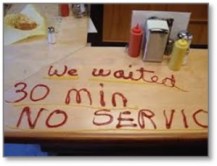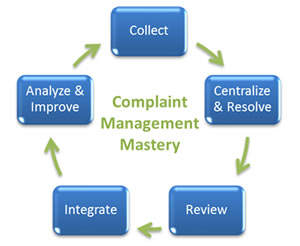Small Business Banking
Web & Mobile Banking
Retail Banking
call center
Best Practices
Branch Sales & Service
5 Steps to Mastering Banking Complaints from Customers

 News flash! Banking customer experience should be best in class at most businesses in America this year.
News flash! Banking customer experience should be best in class at most businesses in America this year.
According to a 2010 Forrester study, 80% of financial services companies would like to use customer satisfaction as a form of differentiation. If all of those five-year plans were developed and executed, then customer experience would only be noticed in the 20% that didn’t focus on it.
I just got off the phone with my cell phone company, got a robo response from my bank service, and am filing a consumer complaint with an airline right now so I don’t think that prophesy has come true. While industries have not mastered the fine art of customer experience, it is true that minimum expectations of customer experience are rising every year as more companies take it seriously. This means anyone hoping for a competitive advantage based on customer experience must pursue it with relentless passion because it’s only going to be more difficult each year to stand out.
Manage Banking Customer Experience by Monitoring Bank Complaint Instances
One of the most fundamental pieces to banking customer experience strategy is managing banking complaints. It is an essential piece in a “Voice of the Customer” driven culture. This is an era where every bad customer service experience finds its way onto Facebook, Twitter, YouTube, MeTube, ThemTube and OurTube. To get ahead of the game and stay on top, banks must first master the art of customer complaint management. This process is often overlooked because the belief is that there are other projects that have a higher priority with a better return on investment. The problem isn’t that mismanaging customer complaints doesn’t have a good ROI. The problem is that the ROI ceiling is so high it’s incredibly difficult to quantify. Importantly, with the Consumer Financial Protection Bureau’s influence, complaint management has taken on more of a compliance and pain in the rear tone inside many financial institutions. That approach clearly runs counter to a true customer experience focus with an implementation of ongoing banking process improvement.
Studies regularly provide statistical evidence to support the business case for actively identifying and resolving customer complaints in banks. Return on Behavior Magazine published an article that collected 50 facts about customer experience across a multitude of sources. Within each of the steps below are particularly interesting nuggets culled from the article that underscore the importance of the activity.
 1. Collect (Newbie Level)
1. Collect (Newbie Level)
- For every customer complaint, there are 26 other unhappy customers who have remained silent. (Lee Resource)
- 96% of unhappy customers don’t make bank complaints, however, 91% of those will simply leave and never come back. (1st Financial Training Services)
Proactively collecting banking complaints is critical because it’s one of the rare opportunities to understand how to improve in the eyes of unhappy banking customers. This is especially true since they likely represent a larger group that is finding another bank rather than voicing concerns. Executives should ask themselves how well they are monitoring, organizing and responding to information from the following sources:
- Company web site
- Branches
- Contact center
- Consumer Financial Protection Bureau
- Better Business Bureau
If banks don’t offer customers a channel to voice their complaints against a bank, enraged customers will be forced to air their grievance publicly and the opportunity to harvest this valuable feedback will be lost. Banks need to provide a tool (a customer satisfaction phone survey, a written complaint box, etc.) for employees to collect this type of information so it can be reviewed internally for performance improvement opportunities. Having a formal bank complain process is a must.
2. Centralize & Resolve (Novice Level)
- A 2% increase in customer retention has the same effect as decreasing costs by 10%. (“Leading on the Edge of Chaos” by Emmet Murphy and Mark Murphy)
- A 10% increase in customer retention levels results in a 30% increase in the value of the company. (Bain & Co.)
Centralizing customer complaints is a subtle step that is necessary to provide organizational insight. A single banking complaint coming through one channel may not seem significant, but it might be the tip of a very unhappy iceberg identifiable when noticing similarities in other channels. Customer complaints are data! A single data point is minimally helpful, but the aggregate knowledge when combined can be powerful.
Of course, retention will only come with attempts to resolve the issues. Merely acknowledging banking complaints isn’t enough to improve retention. Demonstrating that a customer’s issue is being taken seriously requires a sincere effort to understand the circumstances and connect with her to discuss it. Someone within the bank needs to be the owner and evangelist for using complaint data as a strategic asset.
 3. Review (Apprentice Level)
3. Review (Apprentice Level)
- It takes 12 positive experiences to make up for one unresolved negative experience. (“Understanding Customers” by Ruby Newell-Legner)
- Happy customers who get their issue resolved tell four to six people. (White House Office of Consumer Affairs)
Bank complaints should be reviewed at a management level even if the concern was resolved with a quick and simple redress. Senior management reviews should also be established to recognize themes across channels and develop solutions to broad issues. Lastly, ensure there is executive involvement for high profile banking concerns and high value customers. Executives should ask themselves, “How well do aggregated themes and key issues bubble up and get discussed at our senior management meetings?”
4. Integrate (Advanced Level)
- 70% of buying experiences are based on how the customer feels he is being treated. (McKinsey)
- 55% of customers would pay extra to guarantee better service. (Defaqto Research)
The aforementioned reviews are critical to establishing a self-improvement cycle that ultimately includes actionable business initiatives. These are the larger, multi-function projects that are far easier to identify and establish in an introspective culture that actively seeks ways to enhance the customer experience. Business strategies based on a differentiated customer experience are challenging, but they are also very effective if achieved. Integrating insights received directly from customers into business initiatives is a tactical process that supports a customer oriented strategy banking strategy.
5. Analyze & Improve (Master Level)
Mastery of bank complaint management is effectively an exercise in analytics. Treating a bank complaint as data in previous steps can lead to answers to complex questions. This includes developing quantifiable facts to either improve the business or make difficult decisions. Mature analytical capabilities can also lead to solutions that benefit both the bank and its customers.
 Example 1
Example 1
Customer complaints were being reviewed and the team came across what was originally written off as an inconsequential issue. A customer had received a letter notifying him of an offer that he didn’t qualify for based on the status of an account. The team recognized that eligibility could have been determined at the time the letter was sent and initiated an analysis of similar scenarios. The final results were a change in processes that saved $50,000 annually in mail costs. That’s the best kind of result regardless of the final dollar amount.
Example 2
A very high profile question was perplexing a team of analysts. There were several complaints from customers who weren’t receiving financial assistance because they weren’t behind in payments. The company only had assistance programs available to those who couldn’t afford payments and subsequently fell delinquent. The issue was that there wasn’t a way to distinguish between customers who needed assistance so they wouldn’t fall behind and others just seeking rate reductions. Executives were pressuring the team to provide a confident recommendation on whether the cost of expanded enrollment was worth the reduction in customer complaints. Analysis of the population and potential solutions was conducted to find a quantifiable basis for recommendation. It was determined that expanding enrollment of the existing program would cost the company an average of $1,300 for each complaint received and wasn’t sustainable. While this didn’t turn out to be an ideal answer, the company was at least in a position to know the consequences before making a decision.
 Talk Is Cheap
Talk Is Cheap
It’s easy to be part of the 80% that intend to differentiate their banking customer experience, but it’s difficult to be part of the fraction that pulls it off. Simply applying the five steps above isn’t enough because a customer oriented culture needs to be established to support this strategy. However, maintaining a passionate corporate culture isn’t possible unless the employees recognize and support an exemplary model to handling customer concerns.
Remember, bankers: complaints aren’t about compliance and a bureaucratic agency in D.C. They’re about nuggets of gritty knowledge that can seriously improve the customer experience.
-rm
Cornerstone Advisors Can Help Minimize Banking Complaints
Ready to be part of the fraction that pulls off the execution?
One of the greatest challenges facing financial institutions today is the lack of differentiation among competitors. Cornerstone Advisors has teamed with hundreds of banks and credit unions to develop actionable strategic plans with measurable results.
Visit our web site or contact us today to talk about developing a superior banking customer experience strategy.